11章 状语从句的翻译
- 格式:ppt
- 大小:647.50 KB
- 文档页数:36
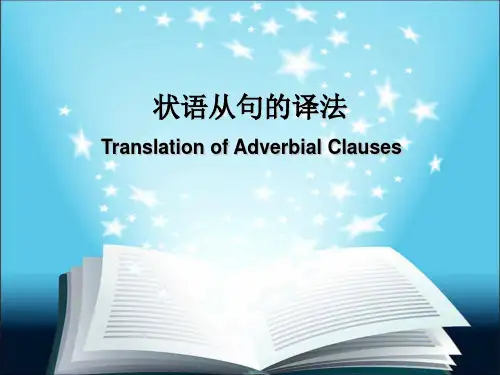
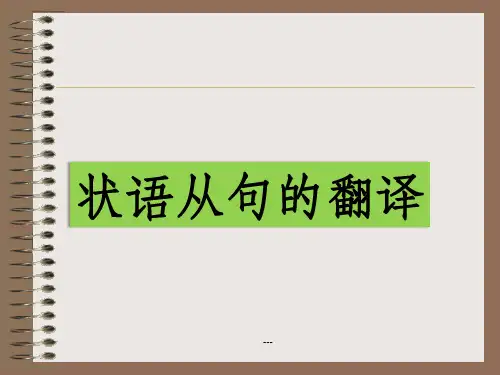
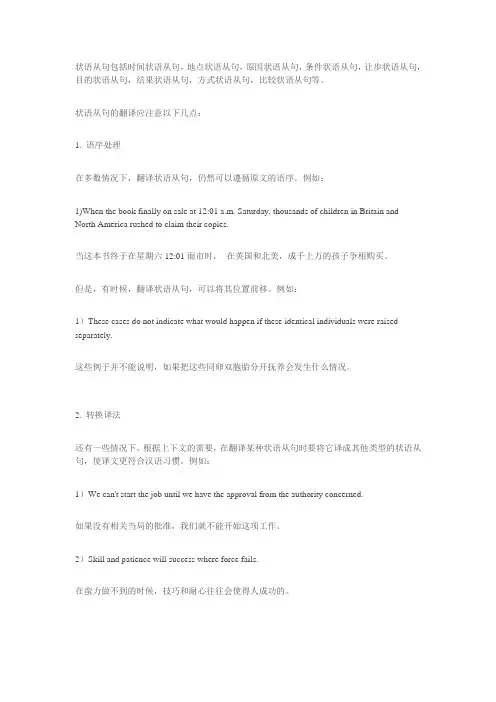
状语从句包括时间状语从句,地点状语从句,原因状语从句,条件状语从句,让步状语从句,目的状语从句,结果状语从句,方式状语从句,比较状语从句等。
状语从句的翻译应注意以下几点:
1. 语序处理
在多数情况下,翻译状语从句,仍然可以遵循原文的语序。
例如:
1)When the book finally on sale at 12:01 a.m. Saturday, thousands of children in Britain and North America rushed to claim their copies.
当这本书终于在星期六12:01面市时,在英国和北美,成千上万的孩子争相购买。
但是,有时候,翻译状语从句,可以将其位置前移。
例如:
1)These cases do not indicate what would happen if these identical individuals were raised separately.
这些例子并不能说明,如果把这些同卵双胞胎分开抚养会发生什么情况。
2. 转换译法
还有一些情况下,根据上下文的需要,在翻译某种状语从句时要将它译成其他类型的状语从句,使译文更符合汉语习惯。
例如:
1)We can't start the job until we have the approval from the authority concerned.
如果没有相关当局的批准,我们就不能开始这项工作。
2)Skill and patience will success where force fails.
在蛮力做不到的时候,技巧和耐心往往会使得人成功的。
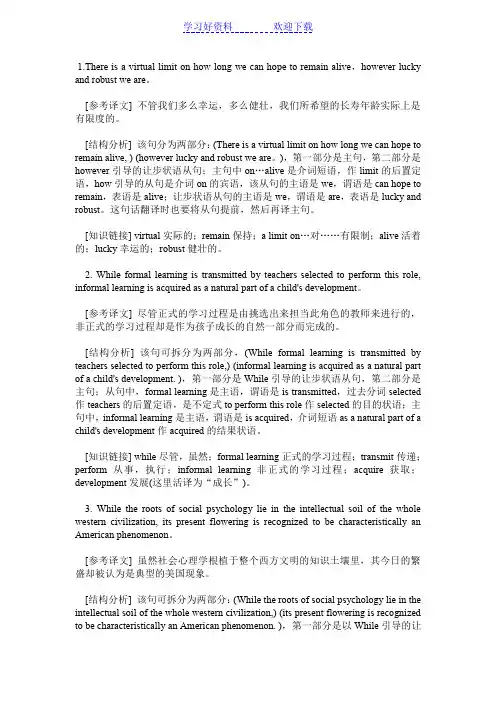
1.There is a virtual limit on how long we can hope to remain alive,however lucky and robust we are。
[参考译文] 不管我们多么幸运,多么健壮,我们所希望的长寿年龄实际上是有限度的。
[结构分析] 该句分为两部分:(There is a virtual limit on how long we can hope to remain alive, ) (however lucky and robust we are。
),第一部分是主句,第二部分是however引导的让步状语从句;主句中on…alive是介词短语,作limit的后置定语,how引导的从句是介词on的宾语,该从句的主语是we,谓语是can hope to remain,表语是alive;让步状语从句的主语是we,谓语是are,表语是lucky and robust。
这句话翻译时也要将从句提前,然后再译主句。
[知识链接] virtual实际的;remain保持;a limit on…对……有限制;alive活着的;lucky幸运的;robust健壮的。
2. While formal learning is transmitted by teachers selected to perform this role, informal learning is acquired as a natural part of a child's development。
[参考译文] 尽管正式的学习过程是由挑选出来担当此角色的教师来进行的,非正式的学习过程却是作为孩子成长的自然一部分而完成的。
[结构分析] 该句可拆分为两部分,(While formal learning is transmitted by teachers selected to perform this role,) (informal learning is acquired as a natural part of a child's development. ),第一部分是While引导的让步状语从句,第二部分是主句;从句中,formal learning是主语,谓语是is transmitted,过去分词selected 作teachers的后置定语,是不定式to perform this role作selected的目的状语;主句中,informal learning是主语,谓语是is acquired,介词短语as a natural part of a child's development作acquired的结果状语。
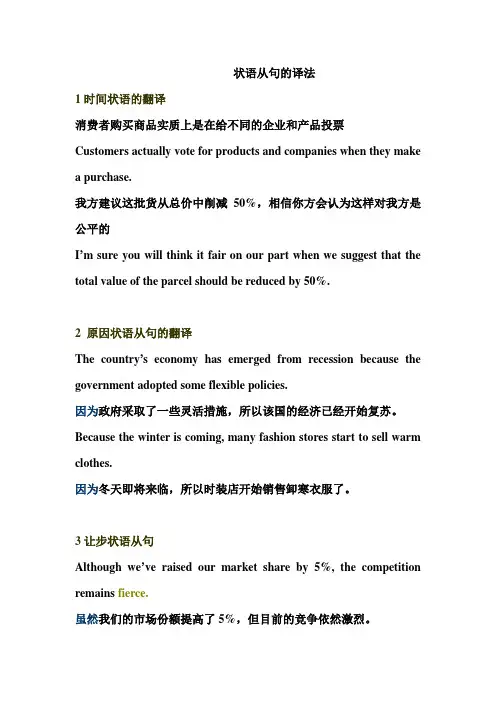
状语从句的译法1时间状语的翻译消费者购买商品实质上是在给不同的企业和产品投票Customers actually vote for products and companies when they make a purchase.我方建议这批货从总价中削减50%,相信你方会认为这样对我方是公平的I’m sure you will think it fair on our part when we suggest that the total value of the parcel should be reduced by 50%.2 原因状语从句的翻译The country’s economy has emerged from recession because the government adopted some flexible policies.因为政府采取了一些灵活措施,所以该国的经济已经开始复苏。
Because the winter is coming, many fashion stores start to sell warm clothes.因为冬天即将来临,所以时装店开始销售卸寒衣服了。
3让步状语从句Although we’ve raised our market share by 5%, the competition remains fierce.虽然我们的市场份额提高了5%,但目前的竞争依然激烈。
4目的状语从句To reduce loss and increase overall profits, the CEO told his product managers to get rid of all the dogs.为了减亏损,全面增加利润,公司的首席执行官告诉产品部的经理们销毁所有的次品。
5条件状语从句So if you should reduce your price by, say 5%, we might come to terms.要是你们答应降价,比如5%,我们达成协议。

状语从句的译法英语状语从句包括表示时间、原因、条件、让步、目的等等各种从句。
我们已经谈到英语状语从句的一些译法。
现在就一些比较常见的处理办法再进一步说明如下:一、表时间的状语从句1.译成相应的表示时间的状语1) While she spoke, the tears were running down.她说话时,眼泪直流。
2) When the history of the Nixon Administration is finally written, the chances are that Chinese policy will stand out as a model of common sense and good diplomacy.当最后撰写尼克松政府的历史时,谈到对华政策可能成为懂得常识和处理外交的楷模。
以上两例译文中表示时间的状语置于句首,与原文一致。
3) Please turn off the light when you leave the room.离屋时请关电灯。
上句原文中表示时间的从句后置,译文中前置。
2.译成“刚〔一〕……就……〞的句式1) He had hardly rushed into the room when he shouted, “Fire! Fire!〞他刚跑进屋就大声喊:“着火了!着火了!〞2) Hardly had we arrived when it began to rain.我们刚一到就下雨了。
3) When I reached the beach, I collapsed.我一游到海滩,就昏倒了。
4) He had scarcely handed me the letter when he asked me to read it.他把信一交给我,就叫我念给他听。
3.译成并列的分句1) He shouted as he ran.他一边跑,一边喊。
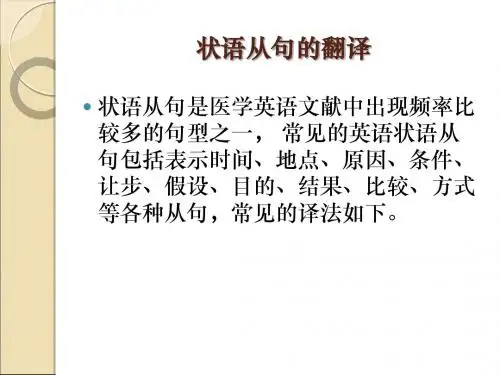

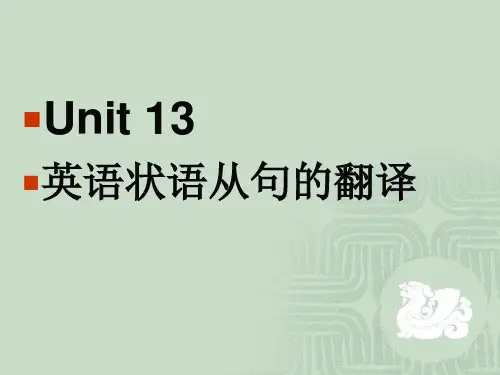
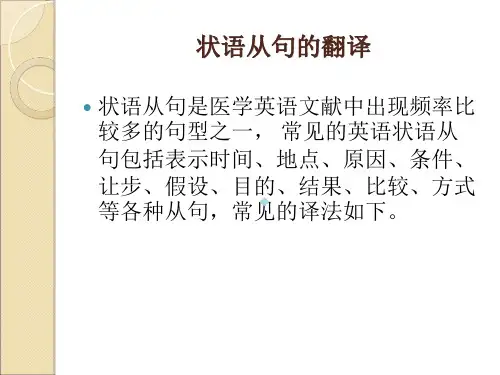

考研英语翻译之状语从句状语从句是考研翻译中很重要的一部分,几乎涉及到每一个长难句,所以我们有必要把状语从句单独拿出来解决。
一般来讲状语从句的翻译相对简单,顺着句子的顺序去翻译就好了,但我们有时候还是会发现有些问题不是很好处理。
首先我们先看一下状语从句的特点。
1?一般情况下,引导英语状语从句的从属连词,基本可以在汉语中找到相对应关联词,但有时不必翻译,因为引导汉语状语分句的关联词时常省略,有近50%的汉语复句中并不使用关联词语而且省略关联词的汉语句子更为精练。
2?英语状语从句的位置颇为灵活,置于主句之前或主句之后均可。
汉语状语分句一般位于主句之前,只有偶尔才位于主句之后。
这是在翻译状语从句时总体来讲应该注意的问题,下面我们从状语从句的几个分支分别来看一下翻译。
(一)时间状语从句的翻译1 译成与汉语完全对应的表示时间的状语例:Whenthey approached Trenton, lights were still burning in manyof the houses and Christ mas parties were still going on.当他们逼近屈兰敦时,许多房子里仍然灯火通明,圣诞晚会还未结束。
由于英汉语言表达的习惯差异,通常汉语的状语从句位于句首,而英语的状语从句可前可后,以后为多。
汉语是一种意合的语言,汉语句子较少使用关联词。
2.翻译成固定(常规)句型一般像由hardly (scarcely ) ….whe n (before ) …no soon er …tha n …as soon as …the mome nt (the in sta nt ) ??? just as …等短语连词引导的时间状语从句翻译成汉语时,主句与从句通常要互换,常常译成包含“刚(一)……就……”这种结构的句子。
同样,包含该结构的汉语句子亦应翻译成英语中相对应的固定句式。
例:计算机刚一启动,就发现有病毒。
状语从句的翻译英语中的状语从句种类繁多,用法复杂,可以用来表示时间、地点、条件、目的、结果、原因、让步、方式、比较等意义。
由于英汉两种语言在表达习惯上的不同,在状语从句的安排上存在着明显的差异。
英语中的状语从句多用在主句后面,而汉语中则习惯于将状语从句放在主句之前,因此在翻译成汉语时一般将状语从句置于主句前面。
当然,对于不同的状语从句,在翻译时也需要根据汉语习惯来灵活翻译。
下面将具体介绍各种状语从句的翻译方法。
一、时间状语从句在英语中,时间状语从句的连接词有:when(当……的时候),whenever(每当……),as(当……时), since(自从……),until (直到……,如果不……),till(直到……),before(在……前),after(在……后),as soon as(一……就……),once(一旦……),the moment(一……就……),immediately(一……就……),no sooner… than(一……就……),hardly/scarcely… when(一……就……),the instant(一……就……),instantly(一……就……),the minute (一……就……),the second(一……就……),every time(每当……),by the time(等到……的时候)等。
在翻译成汉语时,一般应将这些连接词引导的状语从句置于主句前面。
1)译成相应的表示时间的状语。
①与原句顺序一致。
例如:After he had worked in the factory for ten years, he decided to go abroad.在这家工厂工作了十年之后,他决定出国。
While Jack was reading, Jim was writing.杰克阅读的时候,吉姆在写东西。
②后置改前置。
例如:Please turn off the light when you leave the room.离屋时请关灯。
状语从句翻译目的、结果状语从句1.这个外国人以手势助说话,这样他就能使听众明白他的意思。
(so that)2.这位退休教师家住的离学校那么远,我们很少能见到他。
(so….. that)3.我说了什么使他竟然对我那么生气?(that)4.他发音进步很快,英语已经读得非常漂亮。
(such… that)5.大象有强壮的身躯可以为人干重活。
(so… that)6.老师劝我们多带衣服以防天气转冷。
(in case)7.为了不被人轻易认出,这些影星们穿着便装。
(in order that)8.这部有关第一次世界大战的历史小说引人入胜,我简直爱不释手(so… that)。
(上海市高考题)地点状语从句1.他在前天掉的地方找到了他的手机。
(where)2.在涉及到公司的利益之处,我们绝不可能轻易放弃。
(where)3.此后无论何时他有机会,他就会同她说话。
(whenever)4.哪儿有病人和苦难,哪儿就有红十字会的工作人员。
(wherever)让步状语从句1.尽管我承认问题很难,我不同意说它们不能解决。
(while)2.无论我给他们多少忠告,他还是一意孤行。
(no matter how)3.即使我们旅行后很累了,我们仍情绪高昂。
(Even if)4.尽管他喜欢布朗教授的讲课,但不喜欢他的举止。
(though)5.无论你有可能说什么,我都会毫不犹豫地帮助她克服困难。
(whatever)6.这个工人无论怎样努力,他似乎总是不能把工作做得令人满意。
(however)7.不论你是冬天来还是夏天来,你都会觉得这是个居住的好地方。
(whether…or…)8.不管我何时打电话请求帮助,他都会马上来我家。
(whenever)9.今晚无论是谁来串门,告诉他我不到十点钟是不会回来的。
(whoever)10.虽然并不富裕,但是他对自己的生活相当满意。
(Although)(上海市高考题)。